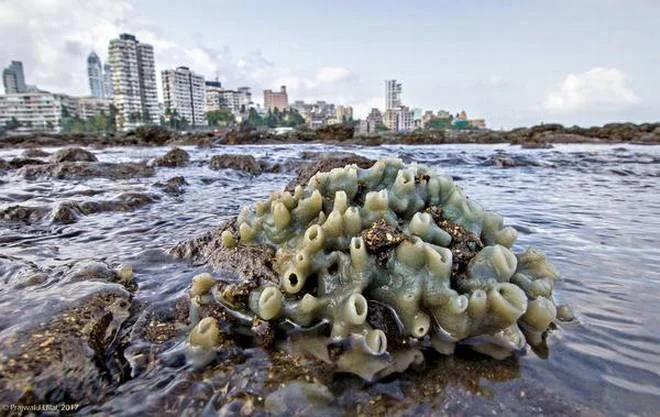Mumbai at See Level: Two New Initiatives Help Residents Learn About the City’s Marine Ecosystem
Most of the city’s inhabitants know very little about its coastlines and marine life, such as this sea sponge spotted along the Haji Ali shore. Photo: Prajwal Ullal
Published in The Hindu – June 2017
Did you know that you can spot colourful clusters of marine sponges on the tetrapods of Marine Drive? Or that the young ones of the lesser flamingo, the pink winter visitors to Mumbai’s mudflats, can recognise their parents’ exact call so that they don’t get lost in their vast nesting colonies?
Mumbai is surrounded by water, but most of the city’s inhabitants know very little about the fascinating coastlines and the marine life that has survived — so far — the excesses of our own lives.
Two recent projects seek to change that, by introducing citizens to the natural world so close to them. These initiatives are vital at a time when new coastal developments — infrastructure projects like the Metro, coastal road, and trans-harbour link, not to speak of commemorative statues and the rapacious builder lobby — threaten to destroy the city’s tenuous links with the ecosystem. These efforts help make citizens aware of the natural wonders Mumbai stands to lose if such ‘development’ is never questioned.
Curating the sea
The Coastal and Marine Biodiversity Centre in Airoli, Navi Mumbai, inaugurated on April 30, is an interactive museum that highlights the region’s varied environments and wildlife.
The Centre is a small two-building complex filled with colourful, informative panels and interactive exhibits in English and Marathi.
In one section, visitors can get acquainted with Mumbai’s mangroves: their root structures, their role in protecting the coast against erosion and how they provide nurseries for various fish and crab species.
Another covers the intertidal zones — areas exposed at low tide — and the various creatures that can be found there, including hermit crabs, mudskippers and molluscs.
Flamingos and the nutrient-rich mudflats that bring them to the city feature in their own section, complete with sound panels that allow visitors to hear what the feathered beauties sound like (imagine a slightly nasal car horn) and a fun, hands-on installation that lets people guide a torch light along a dark screen and look for nocturnal creatures, like bats, snakes and fireflies, that are found in these mudflats.
Similar sound panels in other parts of the centre play the calls of dolphins, white-throated kingfishers and Indian bullfrogs. There’s also a special photo spot where visitors can get their pictures taken with life-size flamingo statues.
The centre is still a work-in-progress with many features yet to be unveiled. N. Vasudevan, Additional Principal Chief Conservator of Forests, said, “In the second phase, we will be working on creation of a boardwalk through the mangroves, a marine mammal museum with displays of whale and dolphin skeletons, and display areas focused on specific groups of marine animals like sea turtles, sharks and coral reefs.”
There is also talk of beginning boat rides in the neighbouring creek after the monsoon.
The Coastal and Marine Biodiversity Centre is open from 9 a.m. to 6 p.m. every day except Fridays. Tickets for adults cost Rs. 50 with discounted prices for students and senior citizens. It is opposite the DAV Public School in Airoli.
Walking the talk
Those interested in a more up-close interaction with Mumbai’s coastal creatures should attend the beach walks conducting by the Marine Life of Mumbai (MLOM) group.
The project is the brainchild of three marine enthusiasts and conservationists: Pradip Patade, Siddharth Chakravarty and Abhishek Jamalabad. “People think that Mumbai’s shoreline is dirty and polluted so it probably doesn’t have much to see,” Mr. Jamalabad says, “but we want to change that thinking and educate them.”
They run an eponymous Facebook page where followers people can post pictures and discuss findings. The trio also conduct free beach walks once a month for a few hours in the morning around low tide; the first walk took place in April, along Girgaum Chowpatty, and the second was in the Haji Ali area. Around 75 people attended both sessions.
The city’s varying shores — from rocky beaches at Haji Ali, Worli and Bandra, to sandy stretches at Girgaum and Dadar, mangroves at Versova and along the Navi Mumbai coast, mudflats at Sewri — are home to a wide variety of marine life. Some of the fascinating organisms that have been spotted so far include graceful salmon-coloured sea anemones, bright blue button jellyfish, multi-coloured sea sponges, marine snails and crimson crabs.
Many participants were amazed by what they saw. “I have lived here my whole life,” says like 26-year-old Sarang Naik, “and I never knew you could see anemones at Girgaum chowpatty.” For Liz Belfer, a 32-year-old teacher from Hong Kong who moved to Mumbai last year, the walks gave her an opportunity to connect with locals who love the ocean as much as she does: “I loved discovering this side of the city, and I’m now part of a couple of Whatsapp groups that keep sharing activities around the city that advocate for conservation and protection of our environment.”
MLOM’s goal, Mr. Jamalabad says, is to create a self-sustaining community of amateur marine conservationists in the city. “We conduct walks only once a month, but it would be great if others organised similar walks on other beaches in the city frequently so we can make more people aware of their surroundings.”
Follow facebook.com/MarineLifeOfMumbai for snapshots of the city’s water world and updates on when the next walk will take place. There will be no walks during the monsoon.
